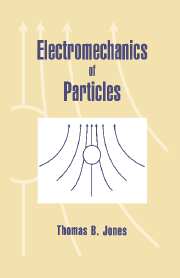Book contents
- Frontmatter
- Contents
- Preface
- Nomenclature
- 1 Introduction
- 2 Fundamentals
- 3 Dielectrophoresis and magnetophoresis
- 4 Particle rotation
- 5 Orientation of nonspherical particles
- 6 Theory of particle chains
- 7 Force interactions between particles
- Appendix A Analogies between electrostatic, conduction, and magnetostatic problems
- Appendix B Review of linear multipoles
- Appendix C Models for layered spherical particles
- Appendix D Transient response of ohmic dielectric sphere to a suddenly applied DC electric field
- Appendix E Relationship of DEP and ROT spectra
- Appendix F General multipolar theory
- Appendix G Induced effective moment of dielectric ellipsoid
- References
- Index
2 - Fundamentals
Published online by Cambridge University Press: 02 December 2009
- Frontmatter
- Contents
- Preface
- Nomenclature
- 1 Introduction
- 2 Fundamentals
- 3 Dielectrophoresis and magnetophoresis
- 4 Particle rotation
- 5 Orientation of nonspherical particles
- 6 Theory of particle chains
- 7 Force interactions between particles
- Appendix A Analogies between electrostatic, conduction, and magnetostatic problems
- Appendix B Review of linear multipoles
- Appendix C Models for layered spherical particles
- Appendix D Transient response of ohmic dielectric sphere to a suddenly applied DC electric field
- Appendix E Relationship of DEP and ROT spectra
- Appendix F General multipolar theory
- Appendix G Induced effective moment of dielectric ellipsoid
- References
- Index
Summary
Introduction
The definition of particle electromechanics offered in Chapter 1, Section 1.2, is very broad, precluding any possibility of definitive treatment in a single volume. Accordingly the scope of this book is restricted primarily to field–particle interactions involving (i) uncharged, lossy, dielectric and electrically conductive particles with AC and DC electric fields and (ii) magnetizable, electrically conductive particles with AC and DC magnetic fields. The particle electromechanics of interest here are a consequence of either the field-induced polarization of dielectric particles or the field-induced magnetization of magnetic particles. The forces and torques governing particle behavior result from the interaction of the dipole and higher-order moments with the field.
Electromechanics of particles
Two distinct types of electromechanical interactions may be identified: imposed field and mutual particle interactions. Imposed field interactions reign when a single particle, or an ensemble of noninteracting particles, is influenced by an externally imposed field. Examples include the dielectrophoretic force or the alignment torque exerted on an isolated particle. Here, it is customary to assume that the particle does not influence the field, though such an assumption is not always justified. Mutual particle interactions occur where particles are so closely spaced that the local field of a particle influences its neighbors. For particles in close mechanical contact, mutual interactions can be very strong, leading to significant changes in the equilibrium structure of particle ensembles (e.g., chain formation and cooperative electrorotation), as well as strong cohesive forces.
For the purpose of convenience in presentation, this monograph is organized into sections on imposed field interactions (Chapters 2 through 5) and mutual interactions (Chapters 6 and 7).
Information
- Type
- Chapter
- Information
- Electromechanics of Particles , pp. 5 - 33Publisher: Cambridge University PressPrint publication year: 1995
Accessibility standard: Unknown
Why this information is here
This section outlines the accessibility features of this content - including support for screen readers, full keyboard navigation and high-contrast display options. This may not be relevant for you.Accessibility Information
- 18
- Cited by
